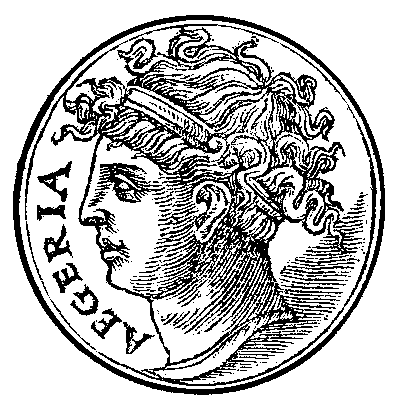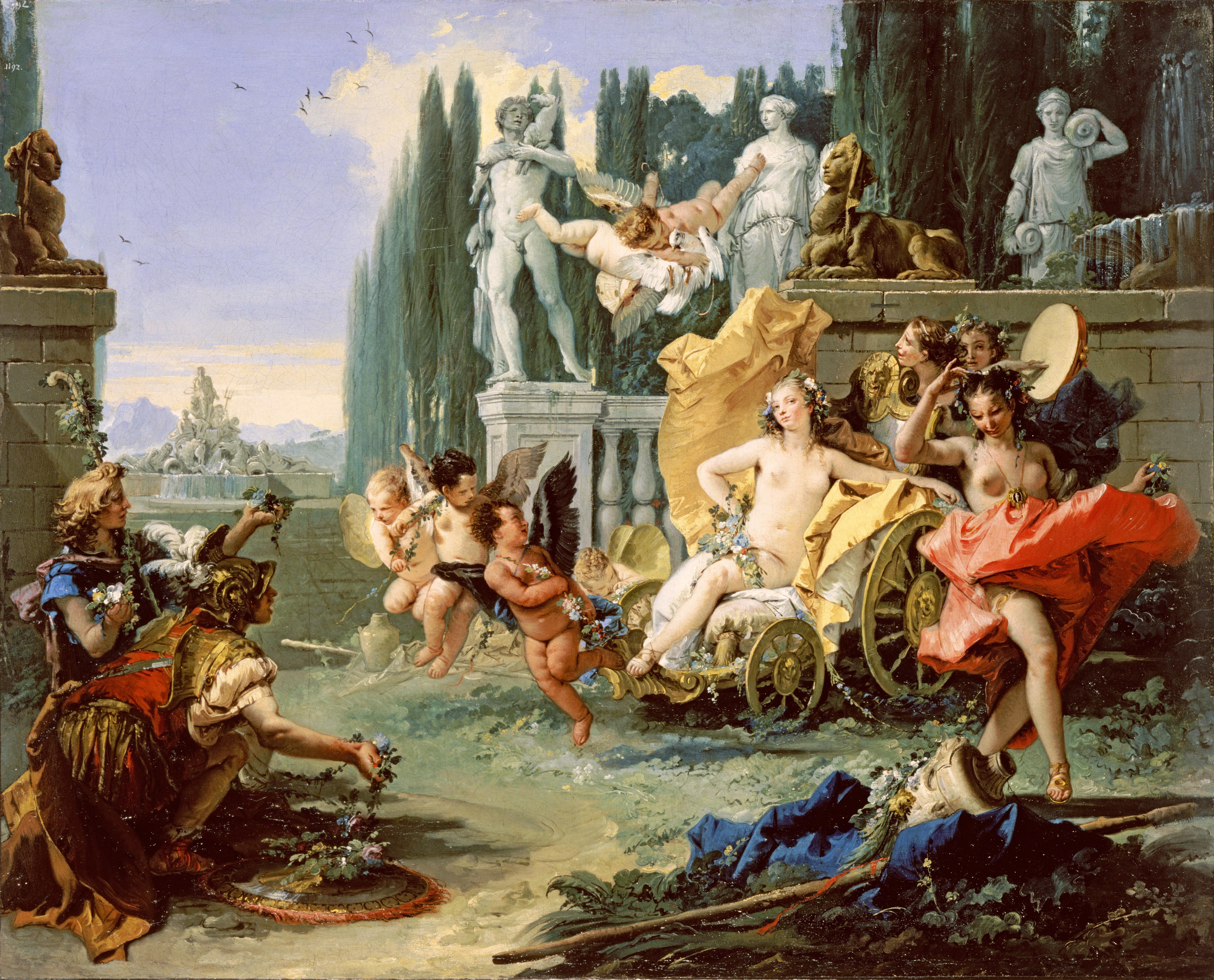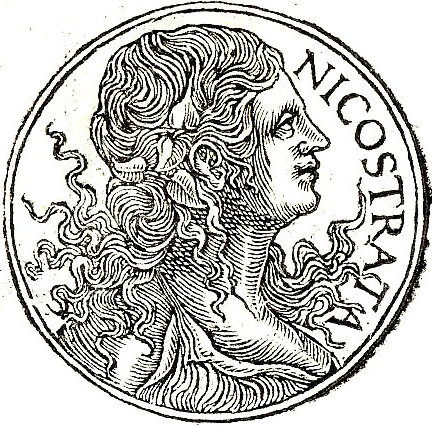|
Postvorta
In Roman mythology, Postverta or Postvorta was the goddess of the past and one of the two Carmentes (along with her sister Antevorta, or prorsa contracted form of ''Proversa''). They were companions of the goddess Carmenta, and probably embodied her aspects as the goddess of the past (Postvorta) and the future (Antevorta, or Prorsa). During childbirth, prayers were offered to summon the Carmentes to preside over the labor.Varro, cited by Aulus Gellius in his ''Attic Nights'', XVI. 16 Porrima was said to be present at the birth when the baby was born head-first; Prorsa, when the feet of the baby came first. See also * Camenae * List of Roman birth and childhood deities In ancient Roman religion, birth and childhood deities were thought to care for every aspect of conception, pregnancy, childbirth, and child development. Some major deities of Roman religion had a specialized function they contributed to this ... References External linksMyth Index - Postverta Child ... [...More Info...] [...Related Items...] OR: [Wikipedia] [Google] [Baidu] |
Antevorta
In ancient Roman religion, Antevorta was a goddess of the future, also known as Porrima. She and her sister Postverta (or Postvorta) were described as companions or siblings of the goddess Carmenta, sometimes referred to as "the Carmentae". They may have originally been two aspects of Carmenta, namely those of her knowledge of the future and the past (compare the two-faced Janus). Antevorta and Postvorta had two altars in Rome and were invoked by pregnant women as protectors against the dangers of childbirth.Varro, cited by Aulus Gellius in his ''Attic Nights'', XVI. 16 Antevorta was said to be present at the birth when the baby was born head-first; Postverta, when the feet of the baby came first. Star name Antevorta is an alternative star name for Gamma Virginis. See also * Atropos * Camenae * List of Roman birth and childhood deities * Skuld Skuld (the name possibly means "debt" and is related to the English word "should") is a Norn in Norse mythology. Along with Urðr (Old No ... [...More Info...] [...Related Items...] OR: [Wikipedia] [Google] [Baidu] |
Roman Goddesses
The Roman deities most widely known today are those the Romans identified with Greek counterparts (see ''interpretatio graeca''), integrating Greek myths, iconography, and sometimes religious practices into Roman culture, including Latin literature, Roman art, and religious life as it was experienced throughout the Empire. Many of the Romans' own gods remain obscure, known only by name and sometimes function, through inscriptions and texts that are often fragmentary. This is particularly true of those gods belonging to the archaic religion of the Romans dating back to the era of kings, the so-called "religion of Numa", which was perpetuated or revived over the centuries. Some archaic deities have Italic or Etruscan counterparts, as identified both by ancient sources and by modern scholars. Throughout the Empire, the deities of peoples in the provinces were given new theological interpretations in light of functions or attributes they shared with Roman deities. An extensive a ... [...More Info...] [...Related Items...] OR: [Wikipedia] [Google] [Baidu] |
Camenae
In Roman mythology, the Camenae (; also ''Casmenae'', ''Camoenae'') were originally goddesses of childbirth, wells and fountains, and also prophetic deities. List of Camenae There were four Camenae: *Carmenta, or Carmentis * Egeria, or Ægeria, or Aegeria *Antevorta, or Porrima *Postverta, or Postvorta, or Prorsa The last two were sometimes specifically referred to as the Carmentae and in ancient times might have been two aspects of Carmenta rather than separate figures; in later times, however, they are distinct beings believed to protect women in labor. Carmenta was chief among the nymphs. Her festival day, the Carmentalia, featured water ritually drawn by Vestal Virgins from the spring outside the Porta Capena. The Camenae were later identified with the Greek Muses; in his translation of Homer's ''Odyssey'', Livius Andronicus rendered the Greek word ''Mousa'' as ''Camena'' and Horace refers to poetic inspiration as the "soft breath of the Greek Camena" (spiritum Graiae tenue ... [...More Info...] [...Related Items...] OR: [Wikipedia] [Google] [Baidu] |
Roman Mythology
Roman mythology is the body of myths of ancient Rome as represented in the literature and visual arts of the Romans. One of a wide variety of genres of Roman folklore, ''Roman mythology'' may also refer to the modern study of these representations, and to the subject matter as represented in the literature and art of other cultures in any period. Roman mythology draws from the mythology of the Italic peoples and ultimately from Proto-Indo-European mythology. Roman mythology also draws directly on Greek mythology, potentially as early as Rome's protohistory, but primarily during the Hellenistic period of Greek influence and through the Roman conquest of Greece, via the artistic imitation of Greek literary models by Roman authors. The Romans identified their own gods with those of the ancient Greeks—who were closely historically related in some cases, such as Zeus and Jupiter—and reinterpreted myths about Greek deities under the names of their Roman counterparts. Greek and ... [...More Info...] [...Related Items...] OR: [Wikipedia] [Google] [Baidu] |
Contraction (grammar)
A contraction is a shortened version of the spoken and written forms of a word, syllable, or word group, created by omission of internal letters and sounds. In linguistic analysis, contractions should not be confused with crasis, abbreviations and initialisms (including acronyms), with which they share some semantic and phonetic functions, though all three are connoted by the term "abbreviation" in layman’s terms. Contraction is also distinguished from morphological clipping, where beginnings and endings are omitted. The definition overlaps with the term portmanteau (a linguistic ''blend''), but a distinction can be made between a portmanteau and a contraction by noting that contractions are formed from words that would otherwise appear together in sequence, such as ''do'' and ''not'', whereas a portmanteau word is formed by combining two or more existing words that all relate to a singular concept that the portmanteau describes. English English has a number of con ... [...More Info...] [...Related Items...] OR: [Wikipedia] [Google] [Baidu] |
Ovid
Pūblius Ovidius Nāsō (; 20 March 43 BC – 17/18 AD), known in English as Ovid ( ), was a Roman poet who lived during the reign of Augustus. He was a contemporary of the older Virgil and Horace, with whom he is often ranked as one of the three canonical poets of Latin literature. The Imperial scholar Quintilian considered him the last of the Latin love elegists.Quint. ''Inst.'' 10.1.93 Although Ovid enjoyed enormous popularity during his lifetime, the emperor Augustus banished him to Tomis, a Dacian province on the Black Sea, where he remained a decade until his death. Overview A contemporary of the older poets Virgil and Horace, Ovid was the first major Roman poet to begin his career during Augustus's reign. Collectively, they are considered the three canonical poets of Latin literature. The Imperial scholar Quintilian described Ovid as the last of the Latin love elegists.Quint. ''Inst.'' 10.1.93 He enjoyed enormous popularity during his lifetime, but the emperor Augus ... [...More Info...] [...Related Items...] OR: [Wikipedia] [Google] [Baidu] |
Fasti (poem)
The ''Fasti'' ( la, Fāstī , "the Calendar"), sometimes translated as ''The Book of Days'' or ''On the Roman Calendar'', is a six-book Latin poem written by the Roman poet Ovid and published in AD 8. Ovid is believed to have left the ''Fasti'' incomplete when he was exiled to Tomis by the emperor Augustus in 8 AD. Written in elegiac couplets and drawing on conventions of Greek and Latin didactic poetry, the ''Fasti'' is structured as a series of eye-witness reports and interviews by the first-person ''vates'' ("poet-prophet" or "bard") with Roman deities, who explain the origins of Roman holidays and associated customs—often with multiple aetiologies. The poem is a significant, and in some cases unique, source of fact in studies of religion in ancient Rome; and the influential anthropologist and ritualist J.G. Frazer translated and annotated the work for the Loeb Classical Library series. Each book covers one month, January through June, of the Roman calendar, and was writ ... [...More Info...] [...Related Items...] OR: [Wikipedia] [Google] [Baidu] |
Aulus Gellius
Aulus Gellius (c. 125after 180 AD) was a Roman author and grammarian, who was probably born and certainly brought up in Rome. He was educated in Athens, after which he returned to Rome. He is famous for his ''Attic Nights'', a commonplace book, or compilation of notes on grammar, philosophy, history, antiquarianism, and other subjects, preserving fragments of the works of many authors who might otherwise be unknown today. Name Medieval manuscripts of the ''Noctes Atticae'' commonly gave the author's name in the form of "Agellius", which is used by Priscian; Lactantius, Servius and Saint Augustine had "A. Gellius" instead. Scholars from the Renaissance onwards hotly debated which one of the two transmitted names is correct (the other one being presumably a corruption) before settling on the latter of the two in modern times. Life The only source for the life of Aulus Gellius is the details recorded in his writings. Internal evidence points to Gellius having been born between AD ... [...More Info...] [...Related Items...] OR: [Wikipedia] [Google] [Baidu] |
Macrobius
Macrobius Ambrosius Theodosius, usually referred to as Macrobius (fl. AD 400), was a Roman provincial who lived during the early fifth century, during late antiquity, the period of time corresponding to the Later Roman Empire, and when Latin was as widespread as Greek among the elite. He is primarily known for his writings, which include the widely copied and read ''Commentarii in Somnium Scipionis'' ("Commentary on the Dream of Scipio") about ''Somnium Scipionis'', which was one of the most important sources for Neoplatonism in the Latin West during the Middle Ages; the ''Saturnalia'', a compendium of ancient Roman religious and antiquarian lore; and ''De differentiis et societatibus graeci latinique verbi'' ("On the Differences and Similarities of the Greek and Latin Verb"), which is now lost. He is the basis for the protagonist Manlius in Iain Pears' book '' The Dream of Scipio''. Name The correct order of his names is "Macrobius Ambrosius Theodosius", which is how it appears ... [...More Info...] [...Related Items...] OR: [Wikipedia] [Google] [Baidu] |
Maurus Servius Honoratus
Servius was a late fourth-century and early fifth-century grammarian. He earned a contemporary reputation as the most learned man of his generation in Italy; he authored a set of commentaries on the works of Virgil. These works, ''In tria Virgilii Opera Expositio'', constituted the first incunable to be printed at Florence, by Bernardo Cennini, in 1471. In the ''Saturnalia'' of Macrobius, Servius appears as one of the interlocutors; allusions in that work and a letter from Symmachus to Servius indicate that he was not a convert to Christianity. Commentary on Virgil The commentary on Virgil ( la, In Vergilii Aeneidem commentarii) survives in two distinct manuscript traditions. The first is a comparatively short commentary, attributed to Servius in the superscription in the manuscripts and by other internal evidence. The second class derive from the 10th and 11th centuries, embed the same text in a much expanded commentary. The copious additions are in contrasting style t ... [...More Info...] [...Related Items...] OR: [Wikipedia] [Google] [Baidu] |
Aeneid
The ''Aeneid'' ( ; la, Aenē̆is or ) is a Latin Epic poetry, epic poem, written by Virgil between 29 and 19 BC, that tells the legendary story of Aeneas, a Troy, Trojan who fled the Trojan_War#Sack_of_Troy, fall of Troy and travelled to Italy, where he became the ancestor of the Ancient Rome, Romans. It comprises 9,896 lines in dactylic hexameter. The first six of the poem's twelve books tell the story of Aeneas' wanderings from Troy to Italy, and the poem's second half tells of the Trojans' ultimately victorious war upon the Latins (Italic tribe), Latins, under whose name Aeneas and his Trojan followers are destined to be subsumed. The hero Aeneas was already known to Greco-Roman legend and myth, having been a character in the ''Iliad''. Virgil took the disconnected tales of Aeneas' wanderings, his vague association with the foundation of Ancient Rome, Rome and his description as a personage of no fixed characteristics other than a scrupulous ''pietas'', and fashioned th ... [...More Info...] [...Related Items...] OR: [Wikipedia] [Google] [Baidu] |
Carmenta
In ancient Roman religion and myth, Carmenta was a goddess of childbirth and prophecy, associated with technological innovation as well as the protection of mothers and children and a patron of midwives. She was also said to have invented the Latin alphabet. Background The name ''Carmenta'' is derived from Latin ''carmen'', meaning a magic spell, oracle or song, and also the root of the English word ''charm''. Her original name was Nicostrate (, "victory-army"), but it was changed later to honor her renown for giving oracles (Latin singular: ''carmen''). She was the mother of Evander of Pallene (fathered by Hermes) and, along with other Greek followers, they founded the town of Pallantium which later was one of the sites of the start of Rome. Gaius Julius Hyginus (''Fab. 277'') mentions the legend that it was she who altered fifteen letters of the Greek alphabet to become the Latin alphabet which her son Evander introduced into Latium. Carmenta was one of the Camenae and the ... [...More Info...] [...Related Items...] OR: [Wikipedia] [Google] [Baidu] |








